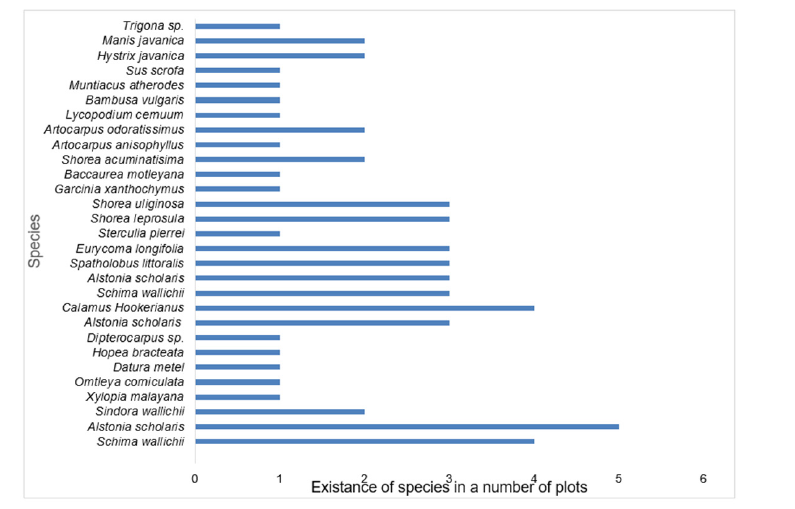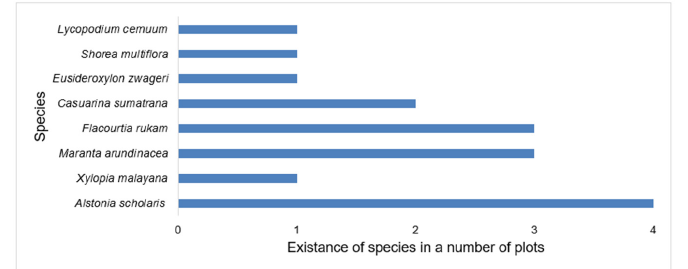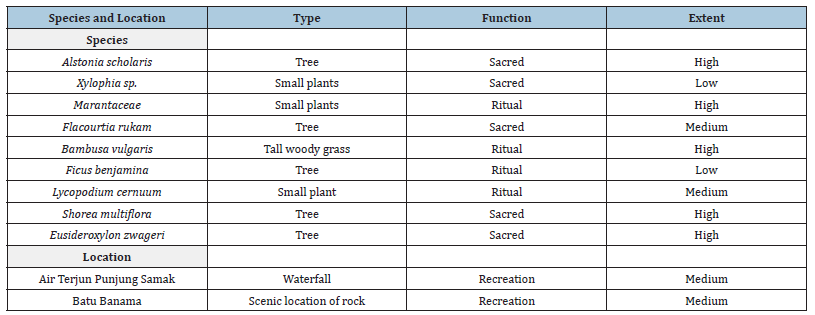- Submissions

Full Text
Biodiversity Online J
Valuing Forest Resources by the Local Community in Sungai Melayu, West Kalimantan
Siti Maimunah1, Trifosa Iin Simamora2, Kishor Prasad Bhatta3, Desintha Yuwindha Prahesty4, Yusuf B. Samsudin5, Amrin Fauzi6, Andi M Amin6, Agam Fatchurrohman6, Syed Ajijur Rahman7*
1Faculty of Forestry, INSTIPER, Indonesia
2Center for International Forestry Research (CIFOR), Indonesia
3Research and Development Centre (RDC), Nepal
4Department of Natural Resources and Environmental Management, Bogor Agricultural University, Indonesia
5Department of Biology, University of Oxford, UK
6PT Bumitama Gunajaya Agro, Indonesia
7International Working Party on Forest Landscape Ecology, (IUFRO, 8.01.02), Austria
*Corresponding author:Syed Ajijur Rahman, International Working Party on Forest Landscape Ecology—(IUFRO, 8.01.02), Austria
Submission: October 10, 2023; Published: October 18, 2023

ISSN 2637-7082Volume4 Issue2
Abstract
Forests provide substantial direct and indirect benefits to local community. However, the effective use of forest products for a local community, vastly depends on the extent of their knowledge and access to forest that they are depending on. This research is aimed to identify local community understanding on the benefits of forest in Sungai Melayu, West Kalimantan, Indonesia. The data collection methods were carried out using nested plots to identify existence of various forest species, Focus Group Discussion (FGD) and field observation to collect data on forest and its usefulness to local livelihoods with the assistance of expert local informants. The research result indicated that Sungai Melayu forest in West Kalimantan is providing various direct (e.g., food, fodder, firewood, timber, and resin) and indirect (e.g., soil erosion control, increase soil fertility, reducing pollution, flood control) benefits to the local communities, including important cultural services. If forest is used and controlled by the local community, it can allow better management of forest than corporate based management, in terms of their scale of use and passion to forest.
Keywords:Species; Livelihood; Extent of benefit; Conservation
Introduction
Indonesia is the largest archipelagic country in the world, having ~18,110 islands and islets [1]. Indonesia also has a rich geological history and diverse habitats, making an area of biodiversity significance in Southeast Asia [2]. Indonesia holds ~10% of the world’s flowering plant species, ~12% of the world’s mammals, ~16% of the world’s reptiles, and ~17% of the world’s bird species [3]. The anthropogenic and cultural diversity of Indonesia is also high, with 1,000 tribes speaking more than 600 languages or dialects, resulting in a massive number of traditions and practices [4]. Such vast cultural diversity causes different understanding and ways to manage local resources, e.g., forest landscape.
In Indonesia, forest management is generally done through decentralized sustainable forest governance, social forestry program. The policy of this program respects customary or collective tenure rights and provides funding for sustainable forest management, communitybased conservation initiatives, and forest and landscape restoration programs (UNDP, 2022). Since 2008, social forestry program has designated ~12.7 million hectares of Indonesian state forest to the indigenous and local communities for their management. The social forestry program allows local communities to manage and develop forests by themselves, e.g., conserving the landscape, planting timber and fruit trees, developing environmental services, and tourism. The direct and indirect benefits derived from the forest can be categorized as ecosystem services, e.g., food, fiber, fuel, medicine, fodder, manure, resins, dyes, pollination, microclimate regulation, air filtration, rainwater drainage, sewage treatment, noise reduction, recreational and cultural values [5,6]. However, the effective use of forest products for a local community, vastly depends on the extent of their knowledge and access to forest that they are depending on. Such knowledge, which is often connected to local culture, can also benefit supporting forest management programs across the landscapes. Therefore, this research is aimed to identify local community understanding on the benefits of forest in Sungai Melayu, West Kalimantan, Indonesia.
Materials and Methods
The study site is located in Sungai Melayu, Ketapang regency, West Kalimantan, Indonesia (Figure 1). Sungai Melayu is a very remote area consists of oil palm plantations, agricultural fields, and forests. The road infrastructure in this area is poor and in a process of development. The total population of Sungai Melayu Village is 3,050 [7]. The data collection method was carried out using a random sampling technique, to identify existence of various forest species in a total of two plots (20x20 m each), in which each plot consists of three nested smaller plots, i.e., 2x2m, 5x5m, and 10x10m. A Focus Group Discussion (FGD) was also conducted to collect data on forest and its usefulness to local livelihoods. Twelve local people were attended the FGD session. People for the FGD were purposively selected based on their good knowledge of local forests and their usefulness; the socioeconomic and geographic states of Sungai Melayu and its surroundings. A set of key FGD questions was prepared that guided the session. A report was prepared after the session summarizing the answers and opinions given by the participants, and to check its validity, the summarized information was verified by the participants. Field observations were also conducted in several locations selected based on the information gathered in the FGD. During observation, several pictures of local landscape were taken, and relevant information was noted. Two local people of Sungai Melayu, who had considerable knowledge of local land use systems, products, uses, were also nominated as expert local informants. These informants were present to assist data collection. Qualitative and quantitative analysis methods were used to analyze the data, particularly the usefulness of Sungai Melayu forest to local community.
Figure 1:Location of study site in Sungai Melayu, West Kalimantan.

Result and Discussion
Total 29 flora and fauna species from Melayu forest provide direct livelihood benefits to the local communities (Figure 2), which include food, fodder, firewood, timber, and resin. Alstonia scholaris provides highest benefit among other species to the local communities, followed by Schima wallichii and Calamus Hookerianus. The wood of Alstonia scholaris is very much useful to use as net floats, household utensils, trenchers, etc. It is also useful in restoring the tone of the stomach after fevers. This tree grows rapidly and is easy to cultivate. The wood of Schima wallichii is used for construction, e.g., door and window frame, and for firewood. Calamus Hookerianus is normally harvested from the forest for its stems, which are mainly used for making baskets and cane furniture. Young shoots of this species also used as a vegetable to make curry and soup. Species from Melayu forest also provide indirect benefits to the local communities, e.g., soil erosion control, increase soil fertility, reducing pollution, flood control. Even though almost all species in the forest can provide indirect benefit in different extent, however, eight species found in our research plots (Figure 3) which are also mentioned by the local people of Sungai Melayu village for indirect benefits. The FGD session and key expert informants used for this research allowed to reveal cultural benefits provided by Sungai Melayu forest (Table 1). The major cultural benefits derived from Sungai Melayu forests (i.e., in a form of trees, small plants, or as a scenic location) are sacred, rituals and recreational purpose.
Figure 2:List of species found in Sungai Melayu forest providing direct benefit to local communities.

Figure 3:List of species found in Sungai Melayu forest providing indirect benefit to local communities.

Table 1:Type of cultural benefit provided by Sungai Melayu forests.

Alike Sungai Melayu forest, many parts in the tropics, forests have gained increasing attention due to the various products and services that people derive from them [8,9]. Forests serve as income sources as well as shelter and consumption of goods, e.g., food, fodder, fuelwood, timber, for local communities [10]. It is estimated that ~1.2 to 1.6 billion people depend to some extent on forests for their livelihoods, which includes 60 million indigenous people [11]. At the national level, forest resources can help foreign exchange earnings through export of forest products [12]. Besides such cash returns from forests, other ecosystem service benefits are far greater [13]. They include climate regulation through carbon sequestration, regulation of water quality and flood risk and air quality, maintenance of supporting services providing primary production through nutrient cycling (minimize nutrient losses and enriching soils through nitrogen fixation), and protecting crops from wind damage [12,14]. In the tropics, forests could absorb as much as 2.8 billion tons of carbon per year [15]. Therefore, forests have important potential to contribute to sustainable development and thereby to a greener economy.
Conclusion
Sungai Melayu forest in West Kalimantan is providing various livelihood benefits to the local communities, including important cultural services. Forest is valuable for this community for generations. The extent of such supporting role of forest to the community depends on the local socio-economic, cultural and environmental conditions. In many parts of the world, if forest is used and controlled by the local community, it can allow better management of forest than corporate based management, in terms of their scale of use and passion to forest. Local communities also access to forest mainly for their local or regional needs rather than large scale export needs; and the local decision-making process can enable community members to participate and to have their voice based on local reality, which is an important element of sustainable forest management.
References
- Kemdikbud (2018) Perhutanan Sosial, Kini Masyarkat Mengelola Hutan. Kementerian Pendidikan, Kebudayaan, Riset, dan Teknologi.
- De Bruyn M, Stelbrink B, Morley RJ, Hall R, Carvalho GR, Cannon CH, Van Den Bergh G, Meijaard E, Metcalfe I, Boitani L, Maiorano L, Shoup R, Von Rintelen T (2014) Borneo and Indochina are major evolutionary hotspots for Southeast Asian biodiversity. Systematic Biology 63: 879-901.
- CBD (2022) Convention on biological diversity-Indonesia.
- Kemdikbud (2018) Perhutanan Sosial, Kini Masyarkat Mengelola Hutan. Kementerian Pendidikan, Kebudayaan, Riset, dan Teknologi.
- Bolund P, Hunhammar S (1999) Ecosystem services in urban areas. Ecological Economics 29: 293-301.
- Sunderland T, Achdiawan R, Angelsen A, Babigumira R, Ickowitz A, Paumgarten F, Reyes-García V, Shively G (2014) Challenging perceptions about men, women, and forest product use: a global comparative study. World Development 64: S56-S66.
- Badan Pusat Statistik Kabupaten Ketapang (2021) Kecamatan Sungai Melayu Rayak Dalam Angka 2021. In A. Hartanto (Ed), 2021-02-17. Badan Pusat Statistik Kabupaten Ketapang.
- Sheil D, Liswanti N (2006) Scoring the importance of tropical forest landscapes with local people: Patterns and insights. Environ Manage 38(1):126-36.
- Vira B, Wildburger, Mansourian S (2015) Forests, trees and landscapes for food security and nutrition. Vienna.
- Rahman SA (2017) Incorporation of trees in smallholder land use systems: Farm Characteristics, rates of return and policy issues influencing farmer adoption. PhD Thesis UK.
- Agrawal A, Hudson J, Shepherd G, Cashore B, Hardin R, et al. (2013) Economic contributions of forests: Present and future. Background paper. United Nations Forum on Forests.
- FAO (2006) Better Forestry, Less Poverty: A Practitioner’s Guide. Italy.
- FAO (2014) State of the World's Forests 2014. Rome.
- Finn D, Mikael KS, Mette FO, Vaithilingam S, Faizal P, et al. (2005) The Asian tsunami: A protective role for coastal vegetation. Science 310 (5748): 643.
- Pan Y, Birdsey RA, Fang J, Houghton R, Kauppi PE, et al. (2011) A large and persistent carbon sink in the World's forests. Science 333: 988-993.
© 2023 Syed Ajijur Rahman. This is an open access article distributed under the terms of the Creative Commons Attribution License , which permits unrestricted use, distribution, and build upon your work non-commercially.
 a Creative Commons Attribution 4.0 International License. Based on a work at www.crimsonpublishers.com.
Best viewed in
a Creative Commons Attribution 4.0 International License. Based on a work at www.crimsonpublishers.com.
Best viewed in 







.jpg)






























 Editorial Board Registrations
Editorial Board Registrations Submit your Article
Submit your Article Refer a Friend
Refer a Friend Advertise With Us
Advertise With Us
.jpg)






.jpg)














.bmp)
.jpg)
.png)
.jpg)










.jpg)






.png)

.png)



.png)






